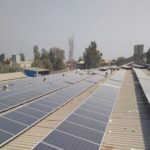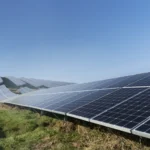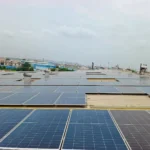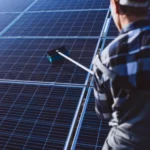Choosing the Right Solar Panel: Complete Guide for India
Choosing the Right Solar Panel: Complete Guide for India
Solar is among the fastest-growing industries in India. This is mainly because solar energy is not only renewable but is also attractive from a financial point of view. As more people are becoming eco-conscious, they have started opting for solar solutions. However, before going solar and installing solar panels, it is important to know the different types of solar panels available in the market. This article discusses the major types of solar panels so that you can make an informed decision before investing in one for yourself.
Let us first understand what are solar panels and how they exactly work.
What is a Solar Panel?
Solar Panels are devices that are used to convert light from the sun into electricity. This is done with the help of photovoltaic cells that generate electricity from the sunlight. Solar panels have become efficient and affordable, making them a suitable alternative to fossil fuels.
How do Solar Panels work?
Let us have a quick look at how the sunlight gets converted into electricity for your homes, offices, or factories. The photovoltaic cells or solar cells on your panels absorb light or photons from the sun and convert it into DC electricity. The solar inverter converts this DC electricity into AC that flows through your homes and factories to power your devices or can be stored in batteries. If there’s excess electricity generated, then it is sent back to the grid.
Types of Solar Panels in India
Although there are many types of solar panels available globally, in India, you will generally get the following three options while buying:
a) Monocrystalline Solar Panels
Monocrystalline first-generation solar panels are made up of black solar cells in which panel light interacts with a single silicon crystal to produce electricity. Monocrystalline solar cells appear black because of the way sunlight interacts with pure silicon. While the cells are black, there’s a variety of colors and designs for the back sheets and frames. Let us see some of the advantages of these solar panels:
- The solar panel is highly efficient and produces a high capacity of power.
- Best for homes and businesses which have limited space.
- The cells are placed in a pyramid pattern, which results in an increased surface area for better absorption of solar energy.
- The monocrystalline cells last for up to 30 years.
- They have great heat resistance.
b) Polycrystalline Solar Panels
In polycrystalline solar panels, several fragments of silicon are melted together to form polycrystalline solar panels. Polycrystalline cells are blue in color because of the way sunlight reflects on the crystals. Sunlight reflects off of silicon fragments differently than it does on a pure silicon cell. These panels are blue in color which helps in increasing the efficiency of the solar panels. Here are some features of these solar panels:
- They are more eco-friendly than monocrystalline cells as they do not require individual shaping and placement of each crystal and most of the silicon is utilized during production. So, very less waste is produced.
- These panels are cheaper than monocrystalline panels which makes them a popular choice among buyers.
- They have high power stability.
c) Thin-film Solar Panels
This is a relatively new technology as compared to monocrystalline and polycrystalline solar panels. Thin-film solar panels are made by depositing a thin layer of a photovoltaic substance onto a solid surface, like glass. They come without frames, set in between glasses. This is what makes them flexible. If you want to meet your energy needs, you would need to install a large number of thin-film panels as their efficiency is low as compared to the first two. These solar panels can be black or blue, depending on the material they were made from.
- They are ideal for use in a number of applications.
- Since they are thin, they are more malleable. They can be manipulated into the shapes of tiles.
- They can be easily rolled up and can be easily transported.
- Have lower costs
- The most distinguishing feature of thin-film panels is that they aren’t always made from silicon. They can be made from a variety of materials, including cadmium telluride (Cd-Te), amorphous silicon (a-Si), and Copper Indium Gallium Selenide (CIGS).
If you are considering buying solar panels for your homes or business, make sure you are aware of the key points before you start with the installation process. Remember, installing either monocrystalline, polycrystalline, or thin-film solar panels will help you reduce your electricity costs and help you create a sustainable lifestyle.
Suggested Articles

Why Go Solar: A Complete Guide to Solar Power for Homes and Industries
Switching to solar energy offers significant savings and environmental benefits. This guide explains why going solar is a smart choice, covering financial incentives, reduced electricity bills, and positive impacts on the planet.

The Rise of Clean Energy: Solar Energy Trends in 2023
The solar energy industry is on the rise, as the demand for clean and renewable energy sources continues to increase. 2023 is shaping up to be a big year for the solar energy sector, as new technologies and innovations are expected to drive growth and expand the reach of solar energy.

Case Study: Successful Design, Installation, and Commissioning of a 50 kWp Rooftop Solar PV Plant
This case study details our experience in designing, installing, and commissioning a 50 kWp solar PV rooftop power plant. Learn how we overcame technical challenges, optimized system performance, and delivered clean, reliable energy. Discover insights on panel selection, inverter sizing, monitoring, and commissioning processes that ensured maximum efficiency and long-term performance for the rooftop solar installation.

Sanctioned Load & Rooftop Solar: Everything You Need to Know
Learn why sanctioned load is crucial before rooftop solar installation. Understand its role, process, and impact on solar panel efficiency and subsidy eligibility.

Poor vs Good Solar Installation: Key Differences Explained
A solar system’s performance depends heavily on installation quality. This blog explains the clear differences between a poor and good solar installation — from wiring practices and panel alignment to mounting structures and system safety — helping you make an informed choice and ensure long-term efficiency.

Solar Savings Made Simple: Know Your Cost Cuts in 2025
Maximize your solar savings in 2025. Learn how solar energy reduces electricity costs for homes and businesses.

Solar O&M Services: How to Ensure Peak Performance & Maximum Power for Solar System
Discover how Solar O&M services keep your solar system running at its best. From routine maintenance to performance monitoring, ensure maximum power and efficiency.

SECI Sets Record in Renewable Energy Trading, Surpasses ₹100 Billion
SECI achieves record renewable power trading revenue surpassing ₹100 billion, marking a milestone in India’s clean energy growth and solar market expansion.